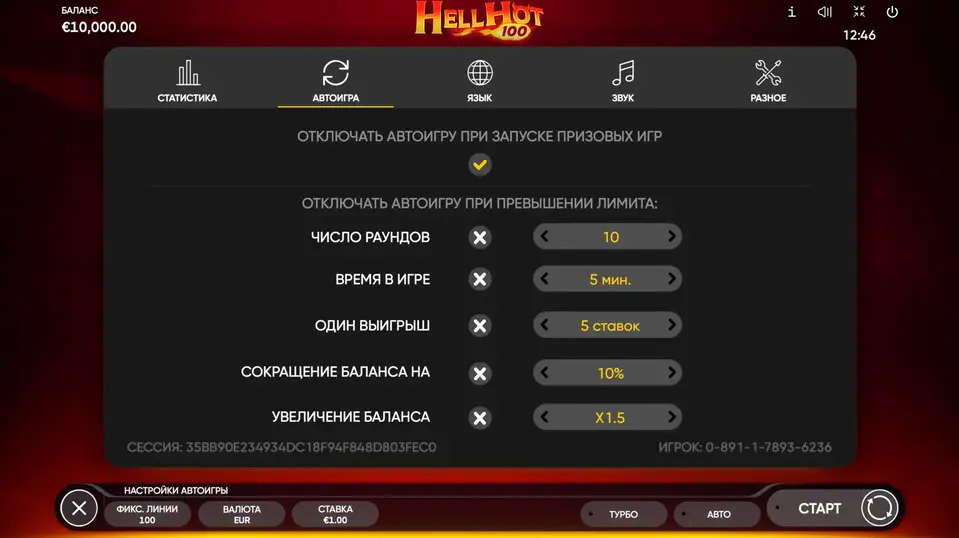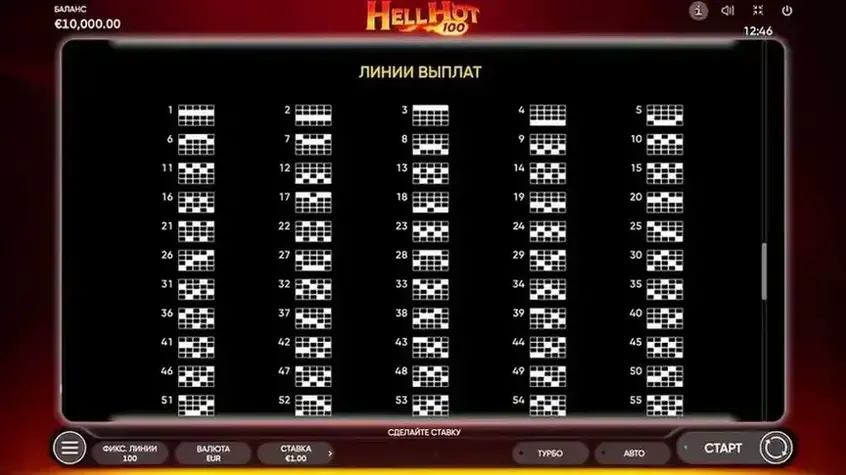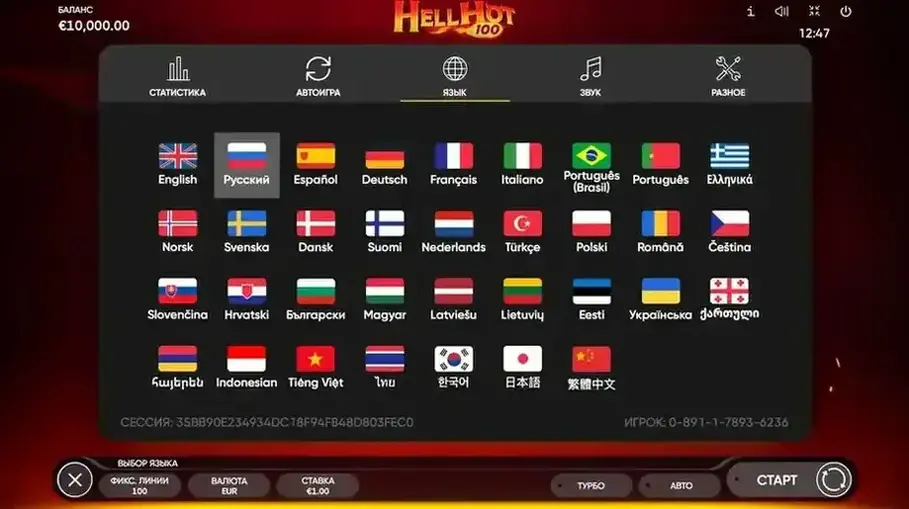Игровой автомат Hell Hot 100: демо, обзор и RTP
Классический фруктовый слот Hell Hot 100 от Endorphina подходит тем, кто ностальгирует по ретро-играм с соответствующим оформлением и легкой мелодией, любит несложные сюжеты, ищет простое развлечение. Автомат выпущен в 2021 году. Слот быстро завоевал внимание как новичков, так и опытных гемблеров. В нем очень легко разобраться, хоть и демо не помешает — такой формат поможет оценить особенности и характеристики.
Обзор Hell Hot 100
Играть в автомат легко. Его особенность — наличие только одной бонусной опции — риск-раунд. Фриспинов, респинов нет. Несмотря на это, каждое вращение может стать успешным. Если игрок впервые знакомится с игровым автоматом Hell Hot 100, вначале стоит попробовать его в демо, а затем уже переходить в режим на деньги. Это позволит убедиться в том, что ограниченный набор бонусных опций не станет преградой для получения хорошей награды.
Игровой автомат основан на проверенных принципах и дополненный вайлдом, скаттером для формирования выгодных комбинаций.

Оформление и дизайн
Провайдер Endorphina вдохновился фруктовой тематикой и решил порадовать поклонников классических слотов. Это видно и в символике — вишня, лимон, арбуз, семерка. При разработке дизайна поставщик использовал современные технологии, поэтому цветовая гамма четкая и насыщенная, анимация качественная, вращения барабанов плавные. Ярко-красный фон слота, языки пламени подчеркивают динамичность геймплея.
Музыка незатейливая, служит только дополнением — не отвлекает от геймплея.

Панель управления
Все кнопки находятся в нижней части, не перегружают оформление. Их 5:
-
номинал монеты — настраивает ее ценность на каждый спин;
-
ставка — выбор количества игровых монет;
-
турбо — ускоренное вращение барабанов;
-
старт — запуск прокрутов;
-
авто — настройка автоматических спин ов.
С помощью левой кнопки открываются статистика и настройки. Здесь можно изменить язык онлайн автомата Hell Hot 100 и настроить звук (включить или выключить), чтобы играть в комфортных условиях.

Игровая механика
Поле состоит из 5 барабанов и 4 рядов. Фиксированных линий — 100.
Скаттер — золотая звезда. Приносит самые крупные призы, что видно уже в демо. В любой момент на поле могут одновременно появиться 5 скаттеров, которые принесут максимальный выигрыш. Это держит гемблеров в постоянном напряжении, усиливает чувство азарта. Скаттеры не запускают фриспины. Этим данный символ отличается от других классических.
Есть и дикие знаки. Они заменяют стандартные символы и дополнительно приносят свои выплаты.

Коэффициенты за появление одинаковых символов в слоте Хел Хот 100 высокие:
| Знак | 3 | 4 | 5 |
|---|---|---|---|
| Арбуз, виноград | х5 | х20 | х50 |
| Слива, апельсин | х3 | х10 | х25 |
| Лимон, вишня | х2 | х5 | х20 |
| Красная семерка | х10 | х30 | х100 |
| Звезда | х5 | х20 | х500 |
Размер приза в слоте зависит не только от коэффициентов, но и от ставки.
Выплаты зачисляются при комбинациях, составленных слева направо. В случае образования нескольких выигрышных цепочек, приз выдается за самую лучшую. Исключение составляет скаттер. Его позиции не важны, учитывается только количество.
Диапазон ставок широкий. Стартует от 10 центов и достигает 1000$ за вращение.
Hell Hot 100 бонусы
Есть только один призовой раунд — риск-игра. Она предлагается после каждого выигрышного вращения. Гемблерам доступны 10 попыток подряд. Если они оказываются удачными, геймплей продолжается, в противном случае — завершается. При правильном угадывании результата выплата увеличивается в два раза.
Участники получают 5 карт — 4 из них закрыты, одна (дилерская) открыта. Цель — выбрать среди закрытых. Для победы номинал должен быть выше дилерской карты. Другой вариант — джокер. Он «бьет» любую карту.
Важно правильно оценивать шансы на победу. Если номинал дилерской карты 5 или ниже, игрок может согласиться на раунд. В случае 6, 7, 8 также часто удается получить приз. Если номинал выше, возникает дополнительный риск и от раунда желательно воздержаться.
Hell Hot 100: RTP, max win, волатильность
Демо позволяет оценить параметры и решить, стоит ли играть на рубли.
Установленный RTP Hell Hot 100 средний 96,07%. Коэффициент отдачи показывает, какая сумма возвращается игрокам на длительной дистанции. Параметр общий, поэтому у всех гемблеров одинаковые шансы и сложно предсказать, когда и кому повезет.
Максимальный выигрыш в Hell Hot 100 небольшой — всего х500. Зато шансы на его получение высокие. Для этого достаточно 5 скаттеров на поле.
Волатильность выше средней. Это указывает на то, что призы не будут такими уж частыми, но зато возможны крупные награды. Иногда бывают серии проигрышных вращений, но после них удается сорвать солидную сумму денег.
Стратегии Hell Hot 100
Результаты зависят не только от удачи, но и от его подхода к геймплею. Поэтому важно ориентироваться на такие советы:
-
Начинать с демо. Это позволит понять особенности механики слот-машины и риск-игра.
-
Определиться с банкроллом и оптимальными ставками. Начинать лучше с маленьких сумм, постепенно их увеличивая.
Есть и несколько полезных стратегий, которые тоже помогают игрокам.

Средние ставки
Такие беты помогают играть сбалансировано, без резких колебаний банкролла и повышают шансы на постепенный выход в «плюс».
Игра на короткие дистанции
Стратегия подходит тем, кто предпочитает контролировать расходы и избегать импульсивных решений. Суть — ограничить игровую сессию небольшим числом вращений, например, 30 или 50. Это помогает оценить, насколько слот находится в «выдающем» или «затишном» режиме, не теряя при этом значительную сумму. Такой подход особенно полезен при игре на деньги в Hell Hot 100.
Для удобства можно использовать автоигру, заранее задав число вращений и установив лимиты на общий проигрыш и выигрыш. Это снижает эмоциональную нагрузку и помогает избежать необдуманных ставок, особенно во время серий неудач.
Слот Hell Hot 100: демо
Эта версия исключает финансовые риски.
Благодаря демо Хел Хот 100 удастся определить особенности и продумать тактику. Затем достаточно перейти в режим на рубли и оценить эффективность стратегии, при необходимости, внести корректировки.
Отличий между бесплатным и реальным форматом практически нет — одинаковые правила, одни и те же бонусные опции, характеристики. Единственное — в бесплатной версии не удастся сорвать кэш, а при игре на деньги такой шанс есть, и он высокий.
Hell Hot 100 на деньги
Для начала нужно выбрать надежное онлайн казино, в котором есть слот Hell Hot 100. После регистрации (если она требуется) найдите игровой автомат через поиск или в разделе популярных игровых автоматов. Нажмите на иконку с пылающей семеркой, чтобы перейти в режим игры на реальные средства.
Прежде чем играть в Hell Hot 100 на деньги в казино, настройте удобный размер ставки и, при желании, и, при желании, включите автоигру. Наслаждайтесь процессом, но не забывайте соблюдать правила ответственной игры — особенно при продолжительных сессиях.

Где лучше играть в Hell Hot 100
Важно найти надежное казино. Выбирая азартное заведение, обращайте внимание на наличие лицензии, репутацию, срок работы в гемблинг-индустрии. Известные лицензионные клубы дорожат своей репутацией, поэтому предлагают сертифицированный игровой автомат с характеристиками, установленными провайдером. В таких ситуациях игровой аппарат загружается на сервере поставщика, что гарантирует честный геймплей, без вмешательства персонала казино, и использование ГСЧ. Популярные и надежные казино — Vavada, Pinco, 1xwin, PokerDom, Play Fortuna, JoyCasino.
Плюсы и минусы игрового автомата
Перед тем как играть в Hell Hot 100 на рубли, стоит оценить плюсы и минусы в демо.
| Классический фруктовый слот | Нет фриспинов |
| Простые правила | Низкий показатель максимального выигрыша — х500 |
| Риск-раунд усиливает чувство азарта | |
| Яркая графика |
Важно с помощью демо изучить автомат и только после этого играть на деньги, учиться эффективно управлять банкроллом. Такой подход повышает шансы на выигрыши, при этом всегда стоит помнить, что успех игры во многом зависит от удачи.
FAQ
Можно ли играть в Hell Hot 100 в казино без регистрации?
Предлагается ли мобильная версия?
Есть ли шанс получить крупные выигрыши?
Отзывы
VeroNIKA1991
Кирюха
Sun-Moon38
ВитаЛИНА
Петька





